
|
International investors couldn’t get enough of Mongolia, and Mongolia of them, back in 2010-2011.
With its unending mineral abundance notionally worth trillions, it was said that the world’s busiest place was the area between an investment banker and a Mongolian cabinet minister. IPO deal hunters auctioned cattle-class seats on the few flights into Mongolia. And when they got there, they brawled over who would get the mandate of some mine in this new Saudi, this would-be Qatar-of-the-Steppe.
But it was all for nought. There were no mandates. Commodity prices – and several Mongolian governments, and local banks too – have since tanked. As one-time partners feud in endless disputes, foreign geologists and bankers have been locked up. The tumult in China – the ‘Minegolian’ business plan held that its paydirt would service the never-ending Sino-boom next door – has topped out the torment over the North Asian tundra.
Rainmakers have been spurned and capital markets have not developed. Corporate Mongolia’s best deals are still done elsewhere. All that developable coal, copper, gold, molybdenum and uranium et al still lurks beneath the steppe. Mongolians want to be rich but its ‘resources nationalists’ jealously want to hold onto their bounty.
They can’t have both.
The middle ground is to husband the state’s bounty into a sovereign wealth fund. The government’s preferred model is Singapore’s Temasek Holdings, owned by the finance ministry. Ulaanbaatar mandarins like the look of Singapore’s Government Investment Corp too.
Right mix
But does either model provide the right mix for Mongolia? Singapore’s economy is the antithesis of Mongolia’s, in size, composition and geography. There are no mines in Singapore. Indeed, as every loyal Singaporean was reminded this year upon the death of their supreme leader Lee Kuan Yew, pretty much the only resource he had available from the mid-1960s to build a modern city-state was its people, living on a tiny island. Mongolia’s three million spread themselves over a Europe-sized landmass.
Further reading |
|
Inevitably, if Mongolia follows the Temasek route, there will be differences. In Mongolia’s vigorous post-Soviet democracy, for example, one presumes its First Lady will not be CEO for more than a decade, or at all. And journalists inquiring into how their national nest-egg is invested won’t hazard lawsuits by doing so. More transparency would also be nice. Despite Temasek’s oft-stated commitment to it, Singaporeans – and foreign investors – don’t know how much they pay Ho Ching, Temasek’s CEO and the prime minister’s wife, to manage their $200 billion fund.
Encouragingly, Bayanjargal Byambasaikhan, the boss of Mongolia’s nascent SWF, Erdenes Mongol, says it is crucial that the fund be independent from politicians.
There are numerous, obvious, role models available to Mongolia: Abu Dhabi, Qatar, Kuwait and Norway for starters, or even mining-rich Kazakhstan.
But the Mongolians seem fixed on Singapore. Erdenes Mongol officials have been shuttling south to Orchard Road for lessons in how it is done and Erdenes CEO Byambasaikhan likes Singapore because it’s “neutral, it’s not China or Japan etc.”
That seems an odd reason.